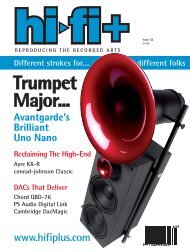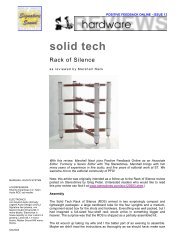Home Audio Equipment Review - Audio Note Singapore
Home Audio Equipment Review - Audio Note Singapore
Home Audio Equipment Review - Audio Note Singapore
You also want an ePaper? Increase the reach of your titles
YUMPU automatically turns print PDFs into web optimized ePapers that Google loves.
<strong>Home</strong> <strong>Audio</strong><br />
<strong>Equipment</strong> <strong>Review</strong><br />
October 2003<br />
Shunyata Research Hydra<br />
Model-8 Power Conditioner<br />
"Chalk up another <strong>Review</strong>ers' Choice<br />
nod for this wonderful product."<br />
by Marc Mickelson<br />
In his great essay "Phyletic Size<br />
Decrease in Hershey Bars," natural<br />
historian Stephen J. Gould discusses<br />
Cope's rule of phyletic size increase,<br />
which notes that most vertebrate<br />
lineages increase in physical size<br />
over time. "The opposite<br />
phenomenon of gradual size<br />
decrease is surpassingly rare," says<br />
Gould, using the Hershey Bar and its<br />
slow but gradual reduction in size<br />
over time as an example. Gould also<br />
notes that with the Hershey Bar, as<br />
size decreases, cost increases --<br />
buyers get less chocolate for their<br />
money. In a comical bit of<br />
extrapolating, Gould shows that<br />
historical patterns "prove" that in the<br />
future the Hershey Bar will weigh<br />
zero ounces but won't cost anything<br />
near zero cents.<br />
Innovation in Design<br />
I'm not sure that phyletic size<br />
increase is necessarily a governing<br />
rule of high-end audio, but it<br />
certainly is true that prices generally<br />
increase as an existing model ages or<br />
becomes completely extinct and is<br />
thereby replaced by a new species --<br />
um, model. How many times have<br />
you seen the Mk II version of any<br />
audio product cost less than its<br />
predecessor? If it did, the company<br />
that makes it would surely have to<br />
concede that it doesn't perform as<br />
well as the original version or have<br />
to ditch features to make up for the<br />
difference in cost.<br />
Behold the Shunyata Research<br />
Hydra Model-8 power conditioner,<br />
the exception to high-end audio's<br />
<strong>Review</strong> Summary<br />
Sound "Characteristic clarity -- as though the original<br />
Hydra were still in use -- but also naturalness<br />
and organic flow"; "resolution was as high as<br />
ever, but it was paired now with a greater<br />
sense of ease and rightness."<br />
Features Complete revision of original Hydra that now<br />
includes eight cryogenically treated outlets<br />
and surge/over-current protection; Shunyata<br />
Research Diamondback power cord comes<br />
standard.<br />
Use "If you want to wring every last iota of<br />
performance out of the Model-8 you'll need to<br />
add one of the upscale and pricey Shunyata<br />
Research power cords, but don't feel like you
variation on Cope's rule. The<br />
original Hydra was wildly<br />
successful, with over 500 sold<br />
before its run came to an end earlier<br />
this year. But instead of just<br />
continuing to produce the Hydra or<br />
coming out with an incrementally<br />
better Mk II unit that costs more, Caelin Gabriel, head tinkerer at Shunyata Research,<br />
decided to redesign the Hydra, taking into account a couple of quips about the original unit.<br />
These include the original's six outlets, which couldn't accommodate complicated audio<br />
systems or larger home-theater systems, as well as the issue of surge protection, which the<br />
original Hydra lacked but some of its competition didn't.<br />
So in re-seeing the Hydra, Gabriel increased its outlet complement from six to eight, with<br />
half of these dedicated to analog use (including preamps and power amps) and half to digital.<br />
He also developed the serious-sounding Trident Defense System and incorporated it into the<br />
Hydra Model-8. This addresses power surges/spikes and over-current conditions in three<br />
ways. First, there's the Venom filter (more creative names!), Shunyata's four-element<br />
capacitive array designed to eliminate over-voltage spikes of only a few volts to beyond 1000<br />
volts on transients. There is also a six-element array of TMOVs that provides 6000 volts of<br />
over-voltage protection and up to 60,000 amps of peak-current protection. TMOVs are,<br />
according the Shunyata Research, "next-generation devices" -- "20mm varistor discs that<br />
have integrated, internal thermal protection" and can't "explode or catch fire in the rare event<br />
of a catastrophic over-voltage condition." Finally, the Hydra Model-8 uses a Carling<br />
electromagnetic circuit breaker with large-surface-area contacts to allow for unrestrained<br />
current flow but also shutdown in the event of over-current episodes that exceed 20 amps.<br />
Shunyata Research is also quick to point out that the Model-8 is rated for 2400 watts of<br />
continuous power delivery -- "day after day."<br />
But there's more in the way of enhancements to the Hydra Model-8 than the extra outlets and<br />
surge/over-current protection. The Model-8’s power-distribution buss array has been refined<br />
and improved. The Model-8's buss bars are machined from cryogenic-grade CDA-101<br />
copper, reportedly the highest purity available, and each is over five inches long and one and<br />
a half inches thick. The entire buss array weighs more than five pounds. The buss system is<br />
housed in a hermetically sealed internal aluminum chassis filled with Shunyata Research’s<br />
FeSi-1002 compound, a synthetically manufactured ceramic material that is said to "perform<br />
a similar noise-reduction function within the Hydra Model-8" as it does within Shunyata<br />
Research's patented power cords. Proprietary Teflon-insulated silver wire, top-grade<br />
cryogenically treated Hubbell outlets, and a 20A Shunyata Research DiamondBack power<br />
cord round out the Model-8. The original Hydra used a 15A twist-lock connector for its<br />
power cord, but the Model-8 replaces this with a more standard 20A connector (not the same<br />
thing as the 15A IEC receptacle on most audio equipment), which makes it a bit easier to<br />
swap out power cords (something I did and will comment on below).<br />
The Hydra Model-8 measures 13"W x 9<br />
1/4"D x 5 3/4"H and weighs 17 pounds.<br />
There are no indicators or switches on the<br />
front panel, with the outlets, 20A connector,<br />
and breaker on the back. One concession to<br />
cost is certainly the new chassis, which looks<br />
nice but is not as classy as the Corian and<br />
granite casework of the original Hydra. If<br />
this matters greatly to you, you will probably<br />
find the Model-8 to be an example of deneed<br />
to do this or you'll suffer."<br />
Value "Shunyata Research has seemingly done the<br />
impossible with the Hydra Model-8: improved<br />
upon a very good existing design in terms of<br />
its functionality and performance, and lowered<br />
its price as well."
evolution. However, like the original unit, the Model-8 is actually a chassis inside of a<br />
chassis, with the inner case holding the buss bars, wiring, and FeSi-1002 compound. Oh, and<br />
one more change: the Model-8 costs $1995 USD, $500 less than the original Hydra.<br />
<strong>Review</strong> system<br />
I used the Hydra Model-8 in two audio systems. In the first system were Magnepan<br />
MG1.6/QR or Thiel CS2.4 speakers, a Mark Levinson No.383 integrated amp, and Esoteric<br />
DV-50 universal audio/video player, all connected with Analysis Plus Solo Crystal Oval<br />
interconnects and Solo Crystal Oval 8 speaker cables. Power cords were Shunyata Research<br />
DiamondBack, Python and Taipan. The second system, my reference system, consisted of<br />
Wilson <strong>Audio</strong> WATT/Puppy 7 speakers driven by Lamm ML2 or ML1.1 amplifiers, a Lamm<br />
L2 Reference preamp, a Zanden Model 5000 Mk III DAC, and a Mark Levinson No.37<br />
transport. Interconnects and speaker cables were from Nordost (Valkyrja) or Shunyata<br />
Research (Aries and Andromeda). I also used a pair of Mark Levinson No.434 amps in this<br />
system. Power cords were Shunyata Research Anaconda Vx, Anaconda Alpha, and Taipan.<br />
In both cases, the power cord to the Model-8 was a 20A-terminated DiamondBack or<br />
Anaconda Alpha -- details on the differences below. For comparison, I used a pair of<br />
heavyweights: an original Shunyata Hydra and a Sound Application XE-12S with 20A Elrod<br />
power cord.<br />
Grant Samuelsen at Shunyata Research ran in the review sample of the Hydra Model-8 for a<br />
while before I received it, and for good measure, I put more time on it before doing any<br />
critical listening.<br />
The eight-headed monster<br />
I wrote a sidebar for our 2001 review of the original Hydra and have used the unit as part of<br />
my reference system since that time. The clarity of the Hydra made it a natural for my<br />
reference system, as did the fact that it replaced a PS <strong>Audio</strong> P300 Power Plant, into which I<br />
could only plug a few of my components. The Hydra was an easy <strong>Review</strong>ers' Choice -- it<br />
offered state-of-the-art performance and cost less than a good amount of its competition.<br />
Imagine then my delight when I first sat down to listen to my all-solid-state second system<br />
with the Hydra Model-8 and heard not only that characteristic clarity -- as though the original<br />
Hydra were still in use -- but also naturalness and organic flow, things I hear in abundance<br />
from my reference Lamm electronics. The quick explanation for all of this would be that the<br />
Hydra Model-8 was further stripping away layers of power-line noise that were not only<br />
masking the clarity of the music but also accounting for the solid-statey character of this<br />
second system. Whatever the case may be, resolution was as high as ever, but it was paired<br />
now with a greater sense of ease and rightness -- elusive characteristics to describe but ones<br />
that are easy to hear when they're there.<br />
For example, not all SACDs are created equal. The sound of some is really nothing to praise<br />
in comparison to that of the finest CDs (although it's often SACD's improvement over the<br />
same CD that matters). A good example of this is pretty much the entire bunch of Peter<br />
Gabriel SACDs (excluding Security [Universal Music 069 493 623-2], which does sound<br />
pretty good on its own). The first three Peter Gabriel solo albums (unofficially titled Car,<br />
Run, and Melt) were never great-sounding on vinyl or CD because they all lack richness and<br />
weight. The Hydra Model-8 doesn't add these things -- it can't work magic -- but it does<br />
allow both a clearer "look" into the recording, which is still not the strength of these SACDs,<br />
and a welcome bit of ease to shine through. Then, on the best-sounding SACDs, like First<br />
Impression Music's Autumn in Seattle [FIM SACD 040] and The Four Seasons [FIM SACD<br />
052], the Model-8 struts, helping to present a sonic picture in which the musicians are
distinct and yet part of the entirety of the soundstage itself, which is extremely well rendered.<br />
Thus, with the Model-8, it's even easier to hear into SACDs, which is really the greatest<br />
strength of the format, and enjoy them even more as well.<br />
After the Model-8's successful debut in my second system, I was eager to move it into my<br />
reference system, where the original Hydra was firmly entrenched. Here, the Model-8 proved<br />
its worth as the Hydra did before it, sounding as lucid as its predecessor but also a touch<br />
more civilized. With this system, however, it's the clarity that matters most, so when Grant<br />
Samuelsen offered a 20A-terminated Anaconda Alpha power cord to use with the Model-8,<br />
"just to see what it can do," I didn't have to think twice. In my reference system, the<br />
Anaconda Alpha is the only choice for use with the Hydra. Bass is more nimble and dynamic,<br />
the midrange is a small degree more see-through, and the system's subjective sense of speed<br />
is greater. Now the bad news: the Anaconda Alpha costs $1995 itself. Ouch.<br />
Why the difference in sound from the power cords? I can only speculate, but the Anaconda<br />
Alpha is designed for use with amplifiers, so it makes sense for a cord that will help an amp<br />
get all of the power it needs to be used on a power conditioner into which an entire system is<br />
plugged. However, paradoxically, in my second system, I found that I liked the Model-8<br />
more with the DiamondBack cord -- perhaps because that system is all solid state, perhaps<br />
because the system's strengths are what the Anaconda Alpha brought to my reference system<br />
-- bass nimbleness, midrange transparency, and speed. Whatever the reason, after you have<br />
become familiar with the Model-8, be willing to experiment with other power cords. I<br />
suspect that Shunyata's $650 Taipan might be the bang-for-the-buck choice for use with the<br />
Hydra Model-8 among all of the company's power cords.<br />
Comparison<br />
I've sort of compared the Hydra and Hydra Model-8 throughout this review, but for greater<br />
context, I also compared the Model-8 to the very fine Sound Applications XE-12S, which I<br />
reviewed sometime back. Functionally, the XE-12S offers surge/spike protection and more<br />
outlets than the Hydra Model-8. It also costs more than double what the Model-8 does<br />
($4200) and doesn't come with its own power cord.<br />
In terms of performance, I found that a gulf existed between the original Hydra and the XE-<br />
12S, with the Hydra sounding more clear and incisive and the XE-12S sounding more full<br />
and easy on the ears. The Model-8 bridges this gap, performing sonically very much like an<br />
amalgam of the original Hydra and the XE-12S. Earlier I would have needed to recommend<br />
one unit or the other to potential buyers based on the sonic outcome they wished to effect.<br />
Not anymore -- the Hydra Model-8 does it all. And if you need the dozen outlets of the XE-<br />
12S, you can buy a second Hydra Model-8 and still have money left over. There's also the<br />
matter of the Anaconda Alpha to consider with that extra cashola.<br />
Finally, while I would say that the Model-8 certainly is better-sounding than the original, and<br />
I feel confident in saying this given that I used it in two rather different systems, the original<br />
Hydra is no slouch and will work wonders in systems for which its added clarity will be a<br />
prized commodity. I can also envision individual components with which the Hydra will be<br />
very useful -- my Bel Canto DAC2 always benefited from it, as did the Esoteric DV-50. I<br />
suspect there will be more than a few original Hydras showing up on the used market, which<br />
means that someone who couldn't afford one new will get a good deal on what is still a very<br />
fine power conditioner.<br />
Conclusion<br />
It's easy to become cynical about high-end-audio equipment, what with the often small
improvements that are wrought for escalating prices. But Shunyata Research has seemingly<br />
done the impossible with the Hydra Model-8: improved upon a very good existing design in<br />
terms of its functionality and performance, and lowered its price as well. The Hydra Model-8<br />
can now be used in a wider array of systems, and its heart as a true high-end product has been<br />
enhanced. I especially like the clarity the Model-8 bring to the music -- a holdover from the<br />
original Hydra -- but the new unit offers an enhanced sense of ease and tonal naturalness as<br />
well. As I noted, if you want to wring every last iota of performance out of the Model-8<br />
you'll need to add one of the upscale and pricey Shunyata Research power cords, but don't<br />
feel that you need to do this or you'll suffer. The Model-8 weaves its sonic spell no matter<br />
which power cord you use to feed it.<br />
The rule of phyletic size decrease may be more rare in nature than the idea of better<br />
performance and functionality at a lower price is in high-end audio, but the Shunyata Hydra<br />
Model-8 proves that it's not a myth. Chalk up another <strong>Review</strong>ers' Choice nod for this<br />
wonderful product.<br />
...Marc Mickelson<br />
marc@soundstage.com<br />
Shunyata Research Hydra Model-8 Power Conditioner<br />
Price: $1995 USD.<br />
Warranty: Five years parts and labor.<br />
Shunyata Research Inc.<br />
5594 N.E. Minder Rd.<br />
Poulsbo, WA 98370<br />
Phone: (608) 850-6752<br />
E-mail: info@shunyata.com<br />
Website: www.shunyata.com<br />
Shunyata Research responds:<br />
All of us at Shunyata Research would like to take this opportunity to thank Marc<br />
Mickelson for his detailed and thorough review of the Hydra Model-8.<br />
Marc Mickelson's review offers convincing testimony of the Hydra Model-8's<br />
performance in differing system contexts. These results are strongly supported by the<br />
following test measurements, which illustrate the Trident Defense System's noise and<br />
transient cancellation capability.
The tests were performed with a production Hydra Model-8 with a switch added that<br />
allows the Trident Defense System to be selectively engaged. The test Hydra Model-8<br />
was connected to a standard 20A duplex outlet. The instrumented test displays were<br />
obtained with a Fluke Model 43 Power Quality Analyzer.<br />
Test 1 illustrates an impulse-noise test. A switched fan was used to create the impulse.<br />
This test simulates the power disturbance that is typical of an inductive load being<br />
switched on or off. Examples are air conditioners, refrigerators, and heating units. The<br />
left image shows the high-energy impulse that appears at the outlet with the Trident<br />
Defense System disabled. The right image clearly illustrates that the all transients and<br />
noise are eliminated when the Trident Defense System is engaged.<br />
Test 2 illustrates a wide-bandwidth-noise source. The noise source used was a paper<br />
shredder, which is similar to other noise sources such as fluorescent lighting, vacuum<br />
cleaners, and dimmers.<br />
We would like to make one point of clarification regarding the optional power cords<br />
available for the Hydra Model-8. The Hydra Model-8 is offered with one of three highcurrent-rated<br />
PaceSetter power cords. In its standard form at an MSRP of $1995, the
Hydra Model-8 comes with the 20A-rated DiamondBack power cord. For those<br />
demanding a higher level of performance and current delivery, we offer the Hydra<br />
Model-8 with the Taipan power cord at $2495. The Hydra Model-8 can also come<br />
supplied with the Anaconda Alpha power cord, but this combination is most commonly<br />
reserved for professional and studio applications.<br />
Thank you again for an accurate and descriptive review of the Hydra Model-8.<br />
Grant Samuelsen<br />
Shunyata Research<br />
• Current Issue <strong>Equipment</strong> <strong>Review</strong>s<br />
All Contents<br />
Copyright © 2003 SoundStage!<br />
All Rights Reserved



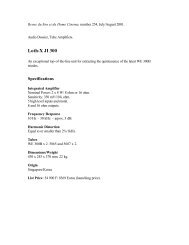
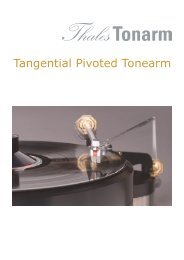
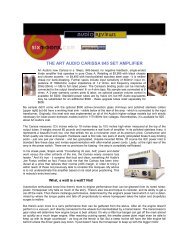
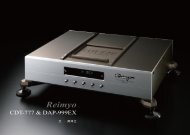

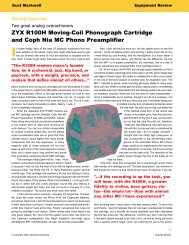
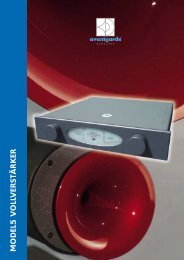
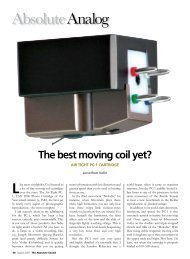
![DAP-999 EX Limited [pdf] - Audio Note Singapore](https://img.yumpu.com/27191044/1/190x253/dap-999-ex-limited-pdf-audio-note-singapore.jpg?quality=85)
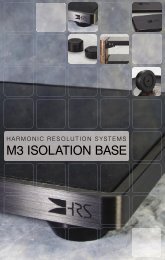
![Harmonix CS-120 Improved-Version [pdf]](https://img.yumpu.com/24411255/1/184x260/harmonix-cs-120-improved-version-pdf.jpg?quality=85)
